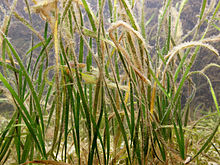
Halodule wrightii

Halodule wrightii, known commonly as shoalweed or shoal grass, is a plant species native to seacoasts of some of the warmer oceans of the world. It has been reported from California, Texas, Florida, Louisiana, Mississippi, Alabama, North Carolina, Maryland, Yucatán, Quintana Roo, Tabasco, Costa Rica, Belize, Panamá, Cuba, Trinidad & Tobago, Venezuela, Brazil, Australia, Cape Verde, and Madagascar. Some publications cite US specimens by the synonym, Halodule beaudettei, but the two names represent the same species. Halodule wrightii is an herb growing in salt-water marshes in intertidal regions, often submerged at high tide but emergent at low tide. It has flat leaves up to 20 cm long, dark reddish-brown, with a few teeth on the margins. Fruits are spherical to egg-shaped, about 2 mm across. Seagrass is a marine angiosperm that possess conductive tissue, shoot systems, rhizomes and flowers. This plant is mainly found in muddy coastal marsh waters and off the coast of many Caribbean islands. They are also found in brackish waters on the east coast of the United States in waters up to 12 meters deep. Halodule wrightii has a fast growth rate with a large shoot density that supplies efficient levels of nutrients to the plant. Rhizome growth and nutrient uptake directly affect each other which causes for such rampant size increase within the seagrass. The rhizome is horizontal underground stem that gathers nutrients for plants. This rapid growth is what makes this species a pioneer plant because it is able to adapt and develop even in oligotrophic conditions. Seagrass are a key component to coastal beaches and marsh habitats due to its importance to marine life, water quality, and nutrient availability. These aquatic plants form sea beds and increase habitat stabilization through constant shoot and rhizome production. The string like structure of the seagrass decrease water turbidity and movement of substrate whether it is sand or mud. Seagrass beds function as an incubator for young juvenile fishes. They provide shelter from predators and reduce competition with other species. Halodule wrightii also supplies food resources to several species of fish, invertebrate marine life and manatees. Such imperative responsibilities lie on seagrass beds, which is why protection and coastal seagrass management is so important to an ecosystem. This species of plant has the ability to adapt to various levels of salinity and temperatures making it a very versatile plant. This plant was named after Charles Wright who was an American botanist and collector. In 1853 and 1856 Wright participated in a surveying expedition and discovered halodule wirghtii. It is commonly known as a pioneer species being that it is one of the first species present in a developing. Halodule wrightii is also able to reproduce sexually and asexually however, flowering in this species is rare.
